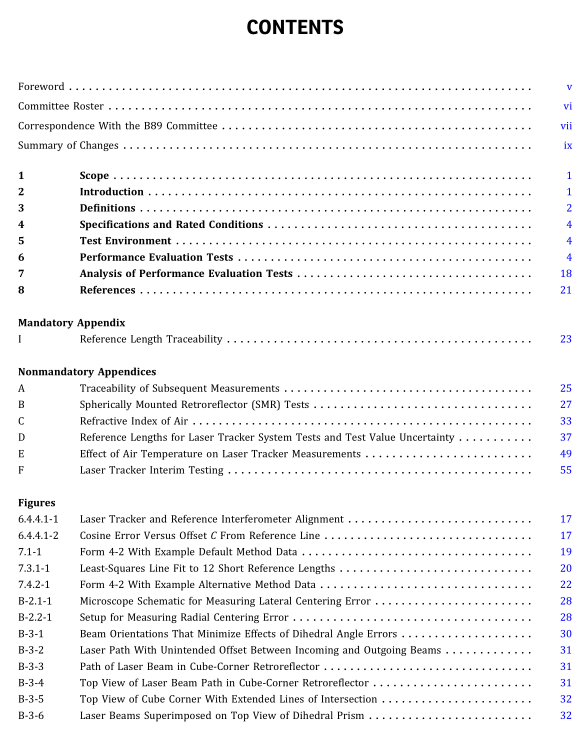ASME B89.4.19-2021 download

ASME B89.4.19-2021 download Performance Evaluation of Laser-Based Spherical Coordinate Measurement Systems
1 ð21Þ SCOPE This Standard prescribes methods for the performance evaluation oflaser-based spherical coordinate measurement systems and provides a basis for performance comparisons among such systems. Definitions, environmental require- ments, and testmethods are included with emphasis on point-to-pointlength measurements. The specified testmethods are appropriate for the performance evaluation ofa majority oflaser-based spherical coordinate measurementsystems and are not intended to replace more complete tests that may be required for special applications. This Standard establishes requirements and methods forspecifyingand testingthe performance ofa class ofspherical coordinate measurement systems called laser trackers.
A laser tracker is a system that directs the light from a range- measuring device to a retroreflecting target (called a retroreflector) by means ofa two-axis rotary steering mechanism while monitoring the angular position of these rotary axes, thereby forming a spherical coordinate metrology system. Such a system may measure a static target, track and measure a moving target, or measure (and perhaps track) some combination ofstatic and moving targets. This Standard can also be used to specify and verify the relevantperformance tests of other spherical coordinate measurement systems that use cooperative targets, such as laser radar systems. This Standard focuses specificallyon the use oflasertrackers as industrial measurementtools ratherthan on theiruse insurveyingorgeodesy.Specifiedtestsaredesignedtoevaluatethestaticpoint-to-pointlengthmeasurementcapabilities ofthese systems.
The specified tests are not intended to evaluate the dynamic performance ofthe laser trackers. Addi- tionaltestsareincludedthatevaluatetherangemeasurementcapabilityoflasertrackersequippedwithabsolutedistance meters (ADMs). Thetests do notevaluateworkpiecethermalcompensationcapabilityandarenotsensitiveto spherically mounted retroreflector (SMR) imperfections.
2 ð21Þ INTRODUCTION Inadditiontoprovidingfortheperformanceevaluationoflasertrackers,thisStandardfacilitatesperformancecompar- isons among different systems by unifying the terminology and the treatment of environmental factors. It defines test methods appropriate forevaluatingthe performance ofa majorityoflasertrackers, butitis notintended to replace more complete tests that may be required for special applications. Systems that have passed the performance evaluation tests of this Standard are considered capable of producing traceable point-to-point length measurements for the conditions required herein. Application of point-to-point length measurements to a specific workpiece or measurement task may require additional testing and analysis in order to establish metrological traceability. This Standard provides technical guidance that may be useful in the cali- bration of laser-based spherical coordinate systems for point-to-point length measurements. The Appendices describe various factors that should be considered when using this Standard.
(a) Mandatory Appendix I discusses metrological traceability, with particular focus on demonstrating traceability of reference lengths used in laser tracker performance evaluation. Requirements for demonstrating metrological trace- ability are presented per ASME B89.7.5.
(b) Nonmandatory Appendix A discusses the traceability of laser tracker point-to-point length measurements performed subsequent to a system passing the performance evaluation tests described in this Standard.
(c) NonmandatoryAppendixB describes tests andprocedures fordetermininggeometricerrors intheconstructionof SMRs so that the suitability of a particular SMR for laser tracker performance testing can be evaluated.
(d) NonmandatoryAppendixC describes environmentalfactors thatinfluencethe refractiveindexoflightinair. These factorsaffectthewavelengthoflightandshouldbecarefullyunderstoodbeforeproceedingwiththetestsdescribedinthis Standard.
(e) Nonmandatory Appendix D describes four methods that can be used to establish a calibrated reference length for point-to-point length measurement system tests. Uncertainties in realization of such lengths are discussed. Nonmandatory Appendix D also describes the measurement capability index and the simple 4:1 acceptance decision rule used to accept or reject laser tracker performance evaluation test results.
(f) Nonmandatory Appendix E describes the effects of spatial temperature gradients on laser beam propagation. Equations are derived for radial errors due to speed-of-light variations and angular (or transverse) errors due to beam refraction. A numerical example illustrates the use of the formulas.
(g) Nonmandatory Appendix F describes a number of interim tests that can be used to quickly assess laser tracker measurement performance in the interval between more complete performance evaluations. This Standard prescribes performance evaluation tests that may be used by laser tracker manufacturers to generate performance specifications. These specifications are stated as the maximum permissible error (MPE) allowed for each test under specified environmental conditions. Laser trackers may be tested against the manufacturer’s specifications by using the performance evaluation tests described in section 6. A typical test involves measuring a known reference length and comparing the observed error (laser-tracker-measured length minus reference length) with the specified MPE using a 4:1 simple acceptance decision rule per ASME B89.
7.3.1-2001 (R2019). The reference length orientations and laser tracker positions in the evaluation have been chosen for their sensitivity to characteristic systematic errors known to occur in these systems.









